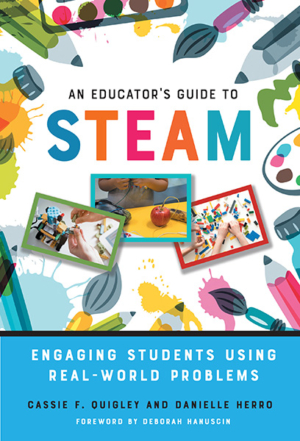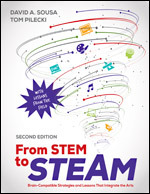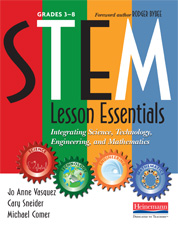***This course fulfills the Washington State OSPI Science, Technology, Engineering and Math Clock hour Continuing Education Requirement
If you have taken this course for graduate credit through ArmchairEd, you cannot take the same course for clock hours through ArmchairEdClockHours.
STEAM—the integration of music, visual arts, and drama into daily STEM instruction—is proven to enhance student achievement in STEM subjects. Creative, real-world problem-solving is what working scientists and mathematicians do. But how do busy STEM educators weave arts activities into a sometimes-inflexible STEM curriculum? This practical course can be used to engage students in K-8 classrooms. Using a conceptual mode with classroom examples and recommendations to use key aspects of STEAM teaching in action, including creating the correct teaching environment, integrating STEAM content, and supporting students as they develop STEAM-related skills. The teaching model includes problems-based learning, student choice, technology integration, and teacher facilitation. Each chapter incorporates elements of connected learning, drawing on students’ interests that teachers can capitalize on when using STEAM to address real-world problems and make STEAM a schoolwide success. This course is great for educators, instructional coaches, principals, and administrators.
Click Here to Buy An Educator's Guide to STEAM Direct from the Publisher
Click Here to Buy From STEM to STEAM Direct from the Publisher
Click Here to Download the Syllabus

 ***This course fulfills the Washington State OSPI Science, Technology, Engineering and Math Clock hour Continuing Education Requirement If you have taken this course for graduate credit through ArmchairEd, you cannot take the same course for clock hours through ArmchairEdClockHours. STEAM—the integration of music, visual arts, and drama into daily STEM instruction—is proven to enhance student achievement in STEM subjects. Creative, real-world problem-solving is what working scientists and mathematicians do. But how do busy STEM educators weave arts activities into a sometimes-inflexible STEM curriculum? This practical course can be used to engage students in K-8 classrooms. Using a conceptual mode with classroom examples and recommendations to use key aspects of STEAM teaching in action, including creating the correct teaching environment, integrating STEAM content, and supporting students as they develop STEAM-related skills. The teaching model includes problems-based learning, student choice, technology integration, and teacher facilitation. Each chapter incorporates elements of connected learning, drawing on students’ interests that teachers can capitalize on when using STEAM to address real-world problems and make STEAM a schoolwide success. This course is great for educators, instructional coaches, principals, and administrators. Click Here to Buy An Educator's Guide to STEAM Direct from the Publisher Click Here to Buy From STEM to STEAM Direct from the Publisher Click Here to Download the Syllabus
***This course fulfills the Washington State OSPI Science, Technology, Engineering and Math Clock hour Continuing Education Requirement If you have taken this course for graduate credit through ArmchairEd, you cannot take the same course for clock hours through ArmchairEdClockHours. STEAM—the integration of music, visual arts, and drama into daily STEM instruction—is proven to enhance student achievement in STEM subjects. Creative, real-world problem-solving is what working scientists and mathematicians do. But how do busy STEM educators weave arts activities into a sometimes-inflexible STEM curriculum? This practical course can be used to engage students in K-8 classrooms. Using a conceptual mode with classroom examples and recommendations to use key aspects of STEAM teaching in action, including creating the correct teaching environment, integrating STEAM content, and supporting students as they develop STEAM-related skills. The teaching model includes problems-based learning, student choice, technology integration, and teacher facilitation. Each chapter incorporates elements of connected learning, drawing on students’ interests that teachers can capitalize on when using STEAM to address real-world problems and make STEAM a schoolwide success. This course is great for educators, instructional coaches, principals, and administrators. Click Here to Buy An Educator's Guide to STEAM Direct from the Publisher Click Here to Buy From STEM to STEAM Direct from the Publisher Click Here to Download the Syllabus If you have taken this course for graduate credit through ArmchairEd, you cannot take the same course for clock hours through ArmchairEdClockHours. This course meets Washington State Science, Technology, Engineering, and Math Clock Hour Requirements STEM Lesson Essentials provides all the tools and strategies you’ll need to design integrated, interdisciplinary STEM (Science, Technology, Engineering, Mathematics) lessons and units that are relevant and exciting to students. The course provides clear definitions of both STEM and STEM literacy, including organizing and delivering instruction by weaving the four disciplines together in intentional ways. The engineering and technology practices can instead be blended into existing math and science lessons in ways that engage students and help them master twenty-first century skills. The course provides five guiding principles for effective STEM instruction, classroom examples of what these principles look like in action, sample activities that put all four STEM fields into practice, and lesson planning templates for STEM units. Click Here to buy the book STEM Lesson Essentials direct from the publisher. Click Here to download the course syllabus.
If you have taken this course for graduate credit through ArmchairEd, you cannot take the same course for clock hours through ArmchairEdClockHours. This course meets Washington State Science, Technology, Engineering, and Math Clock Hour Requirements STEM Lesson Essentials provides all the tools and strategies you’ll need to design integrated, interdisciplinary STEM (Science, Technology, Engineering, Mathematics) lessons and units that are relevant and exciting to students. The course provides clear definitions of both STEM and STEM literacy, including organizing and delivering instruction by weaving the four disciplines together in intentional ways. The engineering and technology practices can instead be blended into existing math and science lessons in ways that engage students and help them master twenty-first century skills. The course provides five guiding principles for effective STEM instruction, classroom examples of what these principles look like in action, sample activities that put all four STEM fields into practice, and lesson planning templates for STEM units. Click Here to buy the book STEM Lesson Essentials direct from the publisher. Click Here to download the course syllabus.